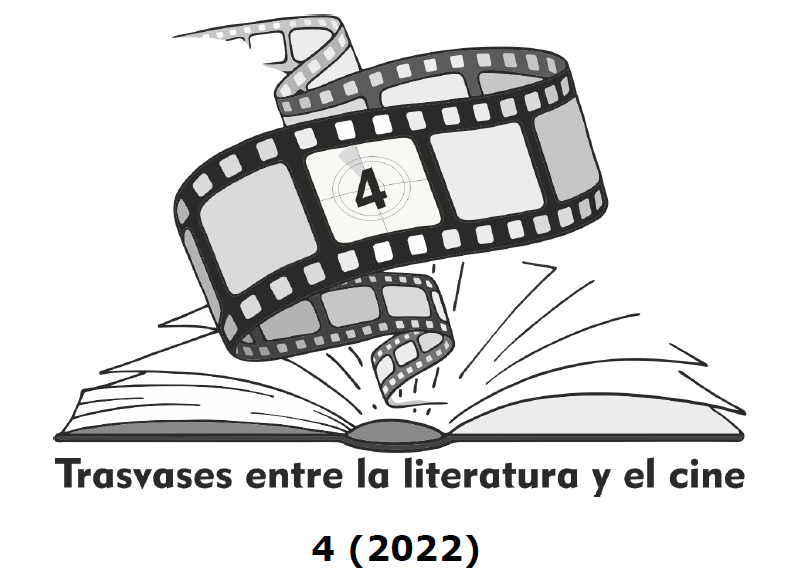Don Quixote in China: don Quixote's cinematic journey through jianghu
DOI:
https://doi.org/10.24310/Trasvasestlc.vi4.14080Keywords:
Don Quixote, film adaptation, cine and literature, Chinese cinema, 3D cinema, wuxia and jianghu, sinicizationAbstract
Over a hundred years have passed since the arrival of El Quijote in China in 1918. During this time, Cervantes’ masterpiece left its mark on both the Chinese literature and other artistic fields. Having reviewed the reception of this classic in that country, this work focuses on the 3D film Don Quixote (2010) by A Gan. The analysis carried out delves into the relations that this production establishes with the previous works of the main filmmakers, the reflections in the Chinese culture on the basis of the historical context, the new narrative meanings, the sinicization of the characters’ features and characteristics, the intermedial references, and the hybridizations between different media presented in the film.
Downloads
Metrics
Publication Facts
Reviewer profiles N/A
Author statements
Indexed in
-
—
- Academic society
- N/A
- Publisher
- Universidad de Málaga
References
A, Gan (2010), ???????? [Biografía de un espadachín caballeresco mágico: Tang Ji Ke De], Filmko Film y GS FILMS et al.
Cao, Zhong (2020), «????????????????» [Características culturales posmodernas de las películas adaptadas de la literatura nacional], Journal of Hunan Mass Media Vocational and Technical College, 20, págs. 25-28.
CCTV 6 (2010), «????????» [Biografía de un espadachín caballeresco mágico: Tang Ji Ke De], CCTV 6. [En línea: http://www.1905.com/mdb/film/337984/feature/?fr=mdbypsy_hxdb. Fecha de consulta: 01/09/2021].
Cervantes, Miguel de (2004), Don Quijote de la Mancha, ed. de Francisco Rico, Barcelona, Galaxia Gutenberg-Círculo de lectores.
Chen, Hong (2013), «????????????——???????????????????????» [La adaptación sinizada de los clásicos de la literatura universal: una interpretación de los elementos culturales nacionales del film Carta de una desconocida], Masterpieces Review, 11, págs. 58-59.
Corrigan, Timothy (2004), «Auteurs and the New Hollywood», en Lewis, Jon. (ed.), The New American Cinema, Durham University Press, págs. 38-63.
Fernández-Cuenca, Carlos (2017), «Historia cinematográfica de Don Quijote de la Mancha», en Emilio de la Rosa et al. (coords.), Cervantes en imágenes, Gráficas Ballesteros, págs. 31-73.
Genette, Gérard (1982), Palimpsestes: la littérature au second degré, París, Éditions du Seuil.
Hamm, Christopher (2005), Paper Swordsmen: Jin Yong and the Modern Chinese Martial Arts Novel, Hawai, University of Hawai’i Press Honolulu.
Han, Fang. (2016), «El viaje a China de Don Quijote de la Mancha», Revista Instituto Confucio, 35/2.
Hao, Yue (2017), «??????????????» [Análisis de los personajes femeninos en las obras de artes marciales de Jin Yong], Language Planning, 8, págs. 61-62.
Huang, Ren (2007), «??????????????????» [Listado de películas adaptadas de obras literarias extranjeras en China], Film Art, 312, págs. 49-51.
Kraemer, Sonia (2009), «Influencias de la filosofía daoísta en los principios estéticos de la pintura china de paisaje», Humania del Sur: Revista de Estudios Latinoamericanos, Africanos y Asiáticos, 4/7, págs. 97-111.
Ma, Xinjie (2021), «Cien años de literatura española en China: análisis cualitativo y cuantitativo», Dicenda. Estudios de Lengua y Literatura Españolas, 39, págs. 123-139.
Ma, Xinjie (2020), La recepción de El Quijote y otras obras de Cervantes en China: traducciones, imitaciones, adaptaciones, Universidad de Jaén [Tesis Doctoral].
Ma, Xinjie, Villén-Higueras, Sergio Jesús y Ruiz-del-Olmo, Francisco Javier (2020), «El Quijote en el cine chino: Biografía de un espadachín caballeresco mágico: Tang Ji Ke De (A Gan, 2010)», Arte, individuo y sociedad, 32/1, págs. 117-131.
Michael, Joachim y Schäffauer, Markus Klaus (2006), «El pasaje intermedial de los géneros», en De Toro, Alfonso (ed.), Cartografías y estrategias de la “postmodernidad” y la “postcolonialidad” en Lationamérica. “Hibridez” y “globalización”, Vervuert Verlagsgesellschaft, págs. 473-516.
Nieto, Rafael (2017), «Tang Ji Ke De (A Gan, 2010)», en Emilio de la Rosa et al. (coords.), Cervantes en imágenes: donde se cuenta cómo el cine y la televisión adaptaron su vida y obra, Gráficas Ballesteros, págs. 446-459.
Peng, Jingyi y Tan, Qiuwen. (2007). «??:“??????????”» [A Gan: “No hay salida para las películas de terror chinas”], Film Art, 2, págs.. 44-48.
Qin, Xinghua (2020), «????IP:?????????????????» [De la literatura a la propiedad intelectual: investigación sobre las películas adaptadas de la literatura desde la perspectiva del arte comparado], Journal of Beijing Film Academy, 6, págs. 30-35.
Qiu, Daidong (2020), «??????????????1992-2019?——?????????????» [El estado de la investigación y los hot spot de las adaptaciones literarias nacionales (1992-2019): análisis visual basado en la bibliometría], Popular literature, 7, págs. 34-35.
Rajewsky, Irina (2005), «Intermediality, intertextuality, and remediation: A literary perspective on intermediality», Intermédialités, 6, págs. 43–64.
Scamuzzi, Iole (2007), Encantamiento y transfiguración. Don Quijote en el melodrama italiano entre los siglos XVII y XVIII, Vigo, Academia del Hispanismo.
Sichuan Daily (2012), «El mito de la taquilla caerá tarde o temprano», People’s Daily Online. [En línea: http://culture.people.com.cn/n/2012/1214/c172318-19903474.html. Fecha de consulta: 20/10/2021].
Song, Geng (2019), «Masculinizing Jianghu Spaces in the Past and Present: Homosociality, Nationalism and Chineseness», Nan Nü, 21, págs. 107-129.
Song, Hwee Lim (2014), «Positioning auteur theory in Chinese cinemas studies: intratextuality, intertextuality and paratextuality in the films of Tsai Ming-liang», Journal of Chinese Cinemas, 1/3, págs. 223-245.
Teo, Stephen (2009), Chinese Martial Arts Cinema: The Wuxia Tradition, Edinburgh, Edinburgh University Press.
Tian, Lin (2010), «??????3D?????——????????????» [La creación de la primera película en 3D de China: explotación de la posproducción de efectos 3D de Tang Ji Ke De], Televion Caption Effects Animation, 11, págs. 8-15.
Tian, Miao y Qin, Xinghua (2012), «??????????????——???????» [Análisis de la adaptación de películas chinas a la literatura extranjera: el caso de The banquet], Film review, 21, págs. 39-40.
Togeby, Knud (1991), La estructura del Quijote, trad. de Antonio Rodríguez Almodóvar, Sevilla, Imprenta A. Pinelo.
Wan, Chuanfa (2020), «??????:???????????????????» [De la literatura al cine: reflexiones sobre los conceptos, teorías, modelos y métodos sobre las adaptaciones], Journal of Shanghai Normal University, 49/1, págs. 111-123.
Wu, Helena Yuen Wai (2012), «Recorridos por ríos y lagos: una mirada al Jianghu intraducible en la cultura y la literatura chinas», 452oF. Revista electrónica de la literatura y literatura comparada, 7, págs. 58-72.
Xu, Hong (2010), ??????????????????1913-1931? [La difusión hacia el este del idioma occidental y la adaptación transcultural de las primeras películas chinas], Universidad de Shanghai [Tesis Doctoral].
Xu, Hong (2011), «??????????????????1913-1977?» [Sobre las películas chinas adaptadas de obras literarias extranjeras (1913-1977)], Journal of Nanjing Arts Institute (Music & Performance), 4, págs. 142-146.
Xu, Zhaoshou y Lin, Heng (2020), «?????????????» [Investigación sobre la relación entre el cine chino y la literatura en los últimos 100 años], Academic Journal of Zhongzhou, 2, págs. 151-159.
Xue, Feng (2011), «?????????????4????» [El director A Gan: la película consiguió recaudar 40 millones de taquilla por sus características], Cinema World, 3, pág. 65.
Yang, Lun (2015), Pensamiento de la pintura paisajística china: hacia una estética filosófica de lo fluido y lo inmaterial, Universidad de Salamanca, [Tesis Doctoral].
Yu, Lu (2010), «???“????”????» [Guotao, don Quijote hace perder la sensatez], East Movie, 10, págs. 128-129.
Zhang, Jing (2016), «????????????????» [Investigación sobre el cine y la televisión adaptada de la literatura extranjera en el nuevo siglo], Masterpieces Review, 6, págs.. 170-171.
Zhang, Ying (2021), «????????????????????» [Desde ¡Vivir! a Tiny Times: cambios en las adaptaciones cinematográficas literarias], Reporter’s Notes, 13, págs. 30-33.
Zhao, Yanhua (2013), «??????????????????» [De Don Quijote de la Mancha a Biografía de un espadachín caballeresco mágico: Tang Ji Ke De], Film Literature, 9, págs. 27-28.
Downloads
Published
How to Cite
Issue
Section
Categories
License
All authors published in this journal accept the following copyright terms:
a. Authors retain their authors´ rights (copyright) and grant First Publication Rights to the journal, which whill be published under a the Creative Commons Attribution-NonCommercial-ShareAlike 4.0 International (CC BY-NC-SA 4.0) license. All about this license is available in the following link: <http://creativecommons.org/licenses/by-nc-sa/4.0>
b. Authors may separately establish additional agreements for the non-exclusive distribution of the version of the work published in the journal (e.g. including it in an institutional repository, or publishing it in a book) with an acknowledgement of its initial publication in this journal.
c. Authors are allowed and encouraged to disseminate their work electronically (e.g. in institutional repositories or on their own website) as this can lead to productive exchanges, as well as earlier and more extensive citation of published work.
The author is responsible for obtaining permission from the copyright holder when using copyrighted materials.
This electronic journal is published by University of Málaga (UmaEditorial), thus it is necessary to cite the origin of any partial or total reproduction.








22.png)










